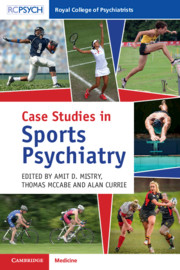Book contents
- Case Studies in Sports Psychiatry
- Reviews
- Case Studies in Sports Psychiatry
- Copyright page
- Contents
- Editors
- Contributors
- Foreword
- Preface
- Chapter 1 American Football: Cognitive Impairment
- Chapter 2 Athletics: Energy Levels, Exercise Addiction and Disordered Eating
- Chapter 3 Boxing: Low Mood and Gambling
- Chapter 4 Cricket: Mental Health Emergencies
- Chapter 5 Cycling: Attention Deficit Hyperactivity Disorder and Anti-Doping
- Chapter 6 Football: Alcohol and Barriers to Support
- Chapter 7 Golf: Alcohol, Anxiety and Sleep Problems
- Chapter 8 Rugby: Concussion and Mental Health Symptoms
- Chapter 9 Swimming: Adolescent Athlete Training Commitments
- Chapter 10 Tennis: Trauma and Tours
- Appendix: International Society for Sports Psychiatry Curriculum 2018
- Index
- Plate Section
- References
Chapter 9 - Swimming: Adolescent Athlete Training Commitments
Published online by Cambridge University Press: 29 July 2020
- Case Studies in Sports Psychiatry
- Reviews
- Case Studies in Sports Psychiatry
- Copyright page
- Contents
- Editors
- Contributors
- Foreword
- Preface
- Chapter 1 American Football: Cognitive Impairment
- Chapter 2 Athletics: Energy Levels, Exercise Addiction and Disordered Eating
- Chapter 3 Boxing: Low Mood and Gambling
- Chapter 4 Cricket: Mental Health Emergencies
- Chapter 5 Cycling: Attention Deficit Hyperactivity Disorder and Anti-Doping
- Chapter 6 Football: Alcohol and Barriers to Support
- Chapter 7 Golf: Alcohol, Anxiety and Sleep Problems
- Chapter 8 Rugby: Concussion and Mental Health Symptoms
- Chapter 9 Swimming: Adolescent Athlete Training Commitments
- Chapter 10 Tennis: Trauma and Tours
- Appendix: International Society for Sports Psychiatry Curriculum 2018
- Index
- Plate Section
- References
Summary
EG is a 16-year-old female who had been told by family, friends and coaches throughout her sporting life that she is destined for the Olympics if she keeps training hard. She has had many successes to date. She trained with a swimming club since she was aged four. E is a top-three short distance national swimmer for her age group. Her most recent success was coming 2nd in the under-15 age category at last summer’s British championships.
- Type
- Chapter
- Information
- Case Studies in Sports Psychiatry , pp. 109 - 121Publisher: Cambridge University PressPrint publication year: 2020

